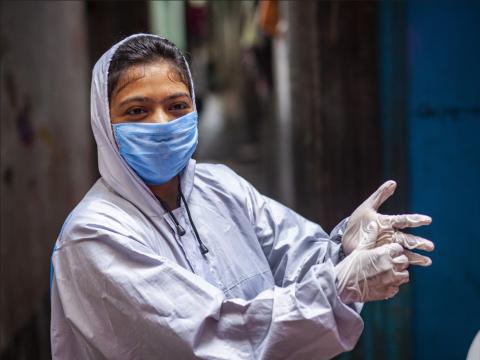Improved wasting recovery with COVID-19 adapted nutrition treatment in South Sudan
This is a summary of the following paper: Lyles E, Banks S, Ramaswamy M et al (2023) Acute malnutrition recovery rates improve with COVID-19 adapted nutrition treatment protocols in South Sudan: a mixed methods study. BMC Nutrition, 9, 1, 1–9. https://doi.org/10.1186/s40795-023-00696-y
Emergency nutrition programme adaptations were implemented globally as part of COVID-19 mitigation strategies. However, the consequences of implementing these protocol changes at scale, particularly in regions facing worsening food security, have not been comprehensively studied. This study describes the impact of COVID-19 on nutrition programming in South Sudan, utilising a mixed-methods approach. The research analysed programme indicators over time by comparing two periods: ‘pre-COVID’ (January 2019-March 2020) and ‘post-COVID’ (April 2020-June 2021).
The researchers conducted a desk review and secondary analysis of facility-level data in South Sudan, focusing on severe and moderate wasting cases. Key indicators included wasting admissions (children aged 6-59 months admitted to outpatient therapeutic programmes and targeted supplementary feeding programmes) and wasting programme exit outcomes (children exiting programmes via recovery, default, death, and non-response - relative to the total number of children in each programme).
The median number of community-based management of acute malnutrition (CMAM) sites in South Sudan increased slightly (+1.85%) during the COVID-19 period. Notably, the analysis of programmatic data from all CMAM reporting sites in South Sudan revealed decreased admissions and improved programme outcomes. For severe wasting, total admissions (-8.2%) and median monthly admissions (-21.8%) both declined during COVID-19, compared to the pre-COVID period. Total moderate wasting admissions increased slightly (+1.1%), while median monthly admissions declined (-6.7%). There were improvements in median monthly recovery rates for both severe (from 92% to 95.7%) and moderate wasting (from 91.5% to 94.3%) across all states. Default and non-recovery rates decreased nationally, while mortality rates remained constant.
It is difficult to attribute declines in admissions to protocol adaptations, as during the pandemic South Sudan experienced concurrent challenges such as flooding, displacement, intensified conflict, and food insecurity, which are all factors that could affect access. States with the largest admission declines also saw reductions in the number of treatment facilities during COVID-19, also suggesting that coverage was a key issue.
The study relies on aggregated facility-level data without individual-level information. This hinders any adjustment for child-level demographic characteristics or nutritional status. Additionally, some sites reported no admissions for extended periods without documentation, which raises the possibility of data inaccuracies. The analysis was also observational, not explanatory, which further limits any interpretation. While the COVID-19 period in this analysis began in April 2020, various protocol revisions occurred at different times and locations beyond this date.
The authors suggest that, in this setting, improved recovery, default, and non-responder rates were observed following the adoption of simplified protocols during the pandemic and that this warrants their continued use. However, given the array of causative and/or confounding factors in this study, any decision on maintaining simplified protocols cannot be based on these findings alone.


